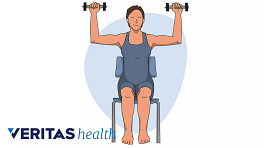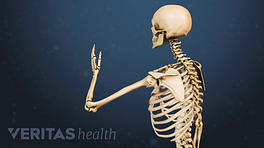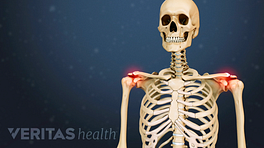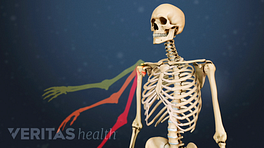Research suggests many people develop acromioclavicular osteoarthritis (AC joint arthritis) as they age. 1 Pennington RG, Bottomley NJ, Neen D, Brownlow HC. Radiological features of osteoarthritis of the acromioclavicular joint and its association with clinical symptoms. J Orthop Surg (Hong Kong). 2008 Dec;16(3):300-2. PubMed PMID: 19126894. Most people who develop AC joint arthritis have one or more risk factors:
In This Article:
Joint trauma
Serious injury or surgery can cause damage to the acromioclavicular (AC) joint and eventually lead to acromioclavicular osteoarthritis, although symptoms may not appear for months or even many years later.
For example, a previous shoulder separation, in which the ligaments that hold the bones of the acromioclavicular joint together were sprained or torn, increases the likelihood of developing acromioclavicular osteoarthritis.
Joint stress and chronic injury
People who spend a lot of time lifting objects overhead can experience “mini-traumas” in their shoulder joints and are more likely to develop acromioclavicular osteoarthritis. People who have spent years weightlifting or participating in high-impact sports, such as hockey,
2
Hacken B, Onks C, Flemming D, et al. Prevalence of MRI Shoulder Abnormalities in Asymptomatic Professional and Collegiate Ice Hockey Athletes. Orthop J Sports Med. 2019;7(10):2325967119876865. Published 2019 Oct 10. doi:10.1177/2325967119876865.
also can be particularly prone to acromioclavicular osteoarthritis.
Congenital defect or illness
Poor bone alignment can increase the risk of shoulder separations, thereby increasing the likelihood of developing osteoarthritis of the shoulder. Other congenital conditions, metabolic disorders, and episodes of gout or septic arthritis can also increase risk.
Advanced age
Cartilage weakens with age, which is why osteoarthritis in all joints is more common in older people. Research suggests many people who are middle aged and older have AC joint osteoarthritis, though many do not have painful symptoms.
1
Pennington RG, Bottomley NJ, Neen D, Brownlow HC. Radiological features of osteoarthritis of the acromioclavicular joint and its association with clinical symptoms. J Orthop Surg (Hong Kong). 2008 Dec;16(3):300-2. PubMed PMID: 19126894.
Family history
Similar to height and hair color, the risk of developing painful osteoarthritis is influenced by genetics. It is not known exactly how much genetics influences the development of AC joint arthritis.
The risk factors listed above make it more likely that a person will develop AC joint arthritis, but do not guarantee it. Some people without any of the above risk factors may develop AC joint arthritis, and people with all of the above characteristics may never develop it.
A sudden onset of pain is more likely to be caused by trauma or another condition, not by osteoarthritis. Likewise, if the acromioclavicular joint feels hot or the skin around the joint turns red, osteoarthritis is probably not the culprit. An infection (if it is only one side) or rheumatoid arthritis may be the cause.
- For symptoms and treatments for another common type of shoulder arthritis, see What Is Shoulder Osteoarthritis?
- 1 Pennington RG, Bottomley NJ, Neen D, Brownlow HC. Radiological features of osteoarthritis of the acromioclavicular joint and its association with clinical symptoms. J Orthop Surg (Hong Kong). 2008 Dec;16(3):300-2. PubMed PMID: 19126894.
- 2 Hacken B, Onks C, Flemming D, et al. Prevalence of MRI Shoulder Abnormalities in Asymptomatic Professional and Collegiate Ice Hockey Athletes. Orthop J Sports Med. 2019;7(10):2325967119876865. Published 2019 Oct 10. doi:10.1177/2325967119876865.











